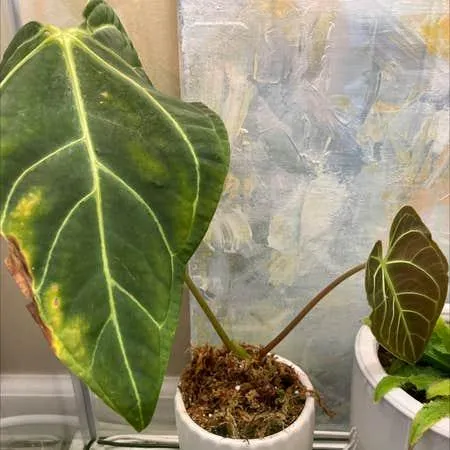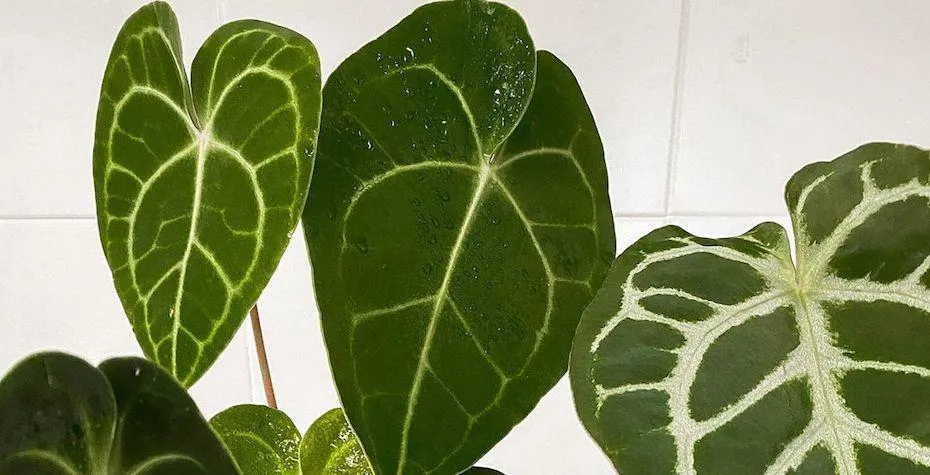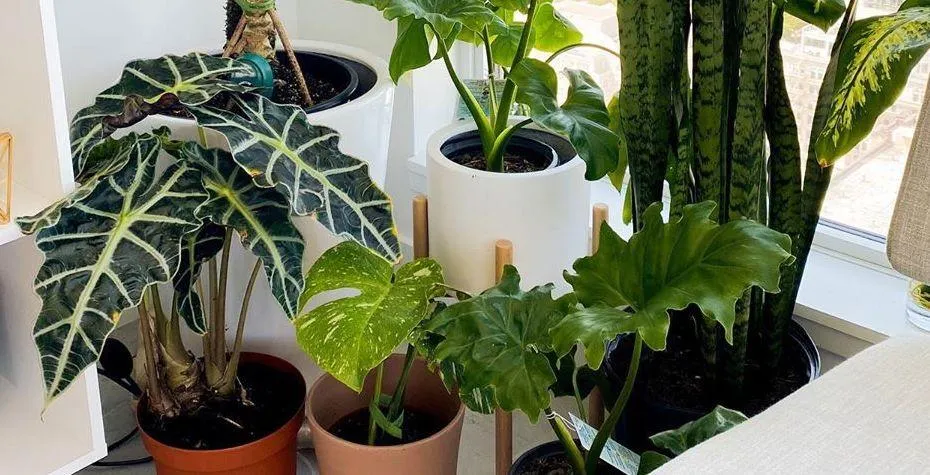Alocasia vs Anthurium: Understanding the Key Differences Between these Tropical Plants
As an avid gardener and plant lover, I’m often asked about the differences between alocasia and anthurium – two popular houseplants with beautiful leaves. While they may look similar at first glance, understanding a few key distinctions can help you choose which type is best for your space. In this article, I’ll break down the main differences between alocasia vs anthurium and hopefully answer all your questions!
Plant Structure
One of the most obvious differences is in plant structure. Alocasia, often called African Mask plant or Polka Dot plant, forms clusters of arrow-shaped leaves rising from a thick underground corm or rhizome. The leaves can range from 4-24 inches long, and some varieties like “Calidora” have distinctive patterns or colors on their leaves. In contrast, anthurium produces heart-shaped leaves on long, pliable stems that emerge from the soil. Individual leaves are usually 6-12 inches long on anthurium.
While both plants produce gorgeous foliage, anthurium is unique in that it blooms as well. Small red, orange, pink or white flowers emerge from the center of the leaves, giving the plant a cheerful, tropical look. You won’t find any flowers on an alocasia. The stems of an anthurium can also twist and bend more than the erect leaves of an alocasia.
Care Requirements
When it comes to care, alocasia is generally a bit hardier than anthurium. Both like temperatures around 70-80°F, but anthurium is more prone to dropping leaves if it gets too hot or cold. They prefer partial to bright indirect light, however alocasia can tolerate a bit lower light levels.

- Watering: Both like moist but well-draining soil. Alocasia tends to be thirstier and needs water roughly once a week. Anthurium needs a bit less – water when the top inch of soil is dry.
- Humidity: High humidity around 50-60% is ideal for both, though anthurium appreciates humidifier use more. Alocasia can cope with drier indoor air.
- Fertilizer: Feed both plants with a balanced houseplant fertilizer diluted to 1⁄2 strength every 2-4 weeks during spring and summer.
Plant Size
Mature alocasia plants generally reach smaller dimensions than anthurium. Most alocasia varieties will stay under 3 feet tall even when well-established. In contrast, large anthurium hybrids can thrive for years in the home and climb walls to heights over 6 feet. So anthurium may not be the best choice if you have limited vertical space.
However, some miniature anthurium varieties top out around 1-2 feet, making them suitable for smaller areas. For folks with tighter quarters, something like “Polly” alocasia or a compact anthurium cultivar could work well.
Toxicity
Both alocasia and anthurium species contain calcium oxalate crystals which can cause irritation or burns if eaten. So keep them out of reach of children and pets. However, from my experience anthurium seems to cause more severe reactions due to higher oxalate levels. If choosing based on safety alone, alocasia would be the better bet for homes with little ones.
Cost and Availability
Generally speaking, alocasia plants tend to be more affordable than anthuriums – especially when comparing mature, well-established specimens. Common alocasia cultivars like “Polly” and “Black Velvet” can often be found for $15-30. Meanwhile, large anthuriums with an abundance of flowers may set you back $50-100.

While alocasia have grown more popular lately, anthurium are still more unusual houseplants at most garden centers. Your best bet for finding a broad selection and rare cultivars is at specialty plant shops or online retailers. Alocasia are easier to find and may be a better choice if you want to experiment with tropical plants on a budget.
Defining Characteristics
To sum it up, here are some key characteristics that help define alocasia vs anthurium plants:
- Plant structure – Alocasia have erect arrow-shaped leaves on thick stems, while anthurium leaves emerge on flexible stems and may twist.
- Blooms – Anthurium bear small flowers amidst their heart-shaped leaves, while alocasia do not bloom.
- Care – Anthurium prefer higher humidity and can be more fussy, while alocasia adapt well indoors.
- Size – Most alocasia stay under 3 feet, versus large climbing anthurium over 6 feet tall.
- Toxicity – Alocasia are safer if small children or pets are present.
- Cost – Alocasia tend to be more affordable than large flowering anthurium.
I hope this breakdown of alocasia vs anthurium has helped answer any questions you may have had! Please let me know if you need any clarification or have additional plant care concerns. Both can make gorgeous accent houseplants, so with the proper care either one would be a great addition to your home. Happy planting!
Alocasia vs Anthurium Plant Comparison
| Plant Type | Leaf Shape | Flower Color | Light Needs | Soil Moisture |
|---|---|---|---|---|
| Alocasia | Broad arrow or heart shaped | None, flowers are small and inconspicuous | Bright indirect light | Keep moist |
| Anthurium | Heart shaped | Various colors like red, pink, white | Bright indirect light | Keep soil slightly moist, not wet |
| Care Level | Moderate | Easy |
FAQ
-
What is the difference between alocasia and anthurium?
Basically, alocasia and anthurium are both types of tropical plants. Alocasia plants tend to have bigger, arrow-shaped leaves compared to anthurium. Anthurium leaves look sort of like heart shapes. So at first glance, the leaf shape and size is the easiest way to tell them apart.

-
Do alocasia and anthurium have similar care needs?
For the most part, alocasia and anthurium have pretty similar care. They both like warm temperatures and high humidity. They’ll be happiest if you mist them often and don’t let the soil dry out totally. They also need bright, indirect light. Perhaps the soils may vary a little – some anthurium varieties prefer soil mixes that retain more moisture. Other than that, the care is rather alike.
-
Do alocasia and anthurium bloom?
Yup, while they’re known for their amazing leaves, both alocasia and anthurium plants can produce flowers too. Alocasia blooms aren’t super showy, just small, greenish flowers. But anthurium flowers come in a huge range of colors like red, pink, orange and white. Their flower shape looks sorta like a heart too. So anthurium blooms are definitely a stunner that make them worth growing, if you want an indoor plant with flowers.
-
Are alocasia or anthurium more difficult to care for?
Generally, most varieties of alocasia and anthurium are pretty similar in terms of how challenging they are to care for. They both need consistent moisture and humidity. However, some specific types may be more tricky than others. For example, some large, tropical alocasia types need really perfect conditions to thrive and may die back if you slip up on watering. Meanwhile, certain large-leafed anthurium can be kinda picky eaters. But most popular houseplant alocasia and anthurium are similarly easy to care for – as long as you meet their basic needs.
-
Are alocasia or anthurium more pest-prone?
Surprisingly, despite their elegant good looks, alocasias are probably a tad more pest-prone than anthuriums. Alocasia are favored snacks for lots of bugs like spider mites, scale, and mealybugs. Those soft, shiny leaves must seem like an all-you-can-eat buffet! Meanwhile, anthuriums have waxy, tough leaves that aren’t as appealing to munch on. So you may have to be a bit more vigilant spraying and inspecting alocasias for pests. But keeping conditions humid helps prevent issues for both types.

-
Do alocasia or anthuriums make good houseplants for beginners?
Both alocasia and anthurium are commonly recommended as good intro tropical plants. While they do need humidity, their care needs are otherwise fairly straightforward – water when top inch of soil is dry. Alocasia and anthurium can tolerate medium to low light. Perhaps anthurium may be the slight winner here for new gardeners, as their waxy leaves help deter pests better. But overall, both genera are very doable for plant newbies and make stunning statement plants for indoor spaces.
On the other hand, while alocasia and anthurium have related needs and abilities, their unique characteristics give each genus its devoted fans. Alocasia lovers are drawn to the bold, prehistoric appeal of their gigantic arrow-like leaves. Anthurium admirers are wowed by the flowers bursting with tropical color. So in the end, deciding between them may simply come down to your personal plant aesthetic preferences. But you can’t go wrong with either if you want a lush indoor jungle!
